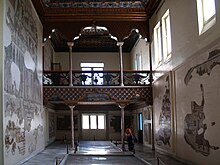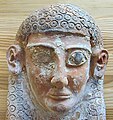Bardo National Museum (Tunis)
This article needs additional citations for verification. (June 2019) |
| |
| Visitors | 664,891 (2005) |
|---|---|
| Curator | Moncef Ben Moussa |
| Website | www |
The Bardo National Museum (
It is one of the most important museums in the Mediterranean region and the second museum of the African continent after the Egyptian Museum of Cairo by richness of its collections.[1] It traces the history of Tunisia over several millennia and across several civilizations through a wide variety of archaeological pieces.
Housed in an old
The museum houses one of the largest collections of Roman mosaics in the world, thanks to excavations at the beginning of 20th century in various archaeological sites in the country including
The museum also houses pieces discovered during the excavations of Libyco-Punic sites including Carthage, although the National Museum of Carthage is the primary museum of the Carthage archaeological site. The essential pieces of this department are grimacing masks, terracotta statues and stelae of major interest for Semitic epigraphy, and the stele of the priest and the child. The museum also houses Greek works discovered especially in the excavations of the shipwreck of Mahdia, whose emblematic piece remains the bust of Aphrodite in marble,[not verified in body] gnawed by the sea.
The Islamic Department contains, in addition to famous works such as the
.In order to increase the reception capacity and optimize the presentation of the collections, the museum is the subject of a vast operation which was to be completed initially in 2011 but was not finished until 2012 due to the Tunisian Revolution. The work concerns the increase of the exhibition surfaces by adding new buildings and redeploying the collections. The project aims to make the museum a major pole for a quality cultural development, so that the visitor can appreciate the artistic pieces deposited.
On March 18, 2015, an Islamist terrorist group
Location and description





The Bardo National Museum building was originally a 15th-century
The Bardo is one of the most important museums of the
In addition to famous works such as the
The Bardo brings together one of the finest and largest collections of Roman mosaics in the world thanks to the excavations undertaken from the beginning of the 20th century on archaeological sites in the country including Carthage, Hadrumetum, Dougga, or Utica. The mosaics represent a unique source for research on everyday life in Roman Africa. The museum also contains a rich collection of marble statues representing the gods and Roman emperors found on various sites including those of Carthage and Thuburbo Majus.
The Bardo has also rich pieces discovered during the excavations of Libyco-
The museum underwent a major refurbishment, completed in 2012, that was interrupted due to the Tunisian revolution. The expansion, which added 9,000 square meters to the complex, was designed by SCPA Codou-Hindley (France) and Amira Nouira (Tunisia). Considerable funding came from the World Bank.[2]
Collections
The museum displays objects ranging from pre-historical artifacts to modern jewelry.
2015 terrorist attack
On 18 March 2015, 24 people were killed in a
Gallery
"Carthaginian art"
-
Anthropomorphic amphora
-
Carthaginian baby bottle. Painted decoration: eyes; palmettes; Tanit....... 3rd century BCE
-
Statue of Baal Hammon sitting on a throne
-
Statue of Tanit leontocephalus
-
Punic jewelry
-
Carthaginian armor from Ksour es-Saf
-
Bottle idol on a stele
-
Stele of Tanit (Carthaginian goddess of fertility)
-
Punic statue
-
Carthaginian granite pebble with figure of deity. 5th century BCE
-
Miniature Punic chapel (naïskos)
-
Priest's stele, discovered in Carthage in 1921. (3rd century BCE. J.-C.).
-
Punic jewellery
-
Statue of Demeter
-
Coroplath statuette holding a tambourine
-
Punic figure of the goddess Tanit with a lion’s head. CE 1st century
-
Punic stelae
-
Stele of the tophet of Salammbô
-
Sculpture of Tanit goddess
-
urn to the Bard, "naïskos"
-
Egyptian style Female mask found in a tomb, known as Protomé Necropolis of Carthage, late 6th - 5th century BCE.
"Famous mosaics"
-
Detail of the Ulysses Mosaic
-
Mosaic of a bottle of wine (2. Jhdt.n.Chr., El Jem-Thysdrus)
-
Ulysses Mosaic
-
Neptune Roman Mosaic
-
Zodiac mosaic
-
Seignor Julius mosaic, CE 5th century, Carthage
-
Matron at her toilet, CE 4th century, Carthage
-
Mosaic of a Wild boar and dog. CE 3rd century
-
Mosaic of a hunting scene. CE 2nd century
-
Roman Christian mosaic of bricklayers at work. CE 4th century
-
Roman mosaic of "Crescentinus diaconus", dating from the CE 4th century. The inscription translates: "The host of the angels, the count of the martyrs, and breathing a peaceful life, may he go to you in a holy manner. Our memory, with the gracious piety with which the deacon Crescentinus is accustomed, returned in peace the 3rd Augustus Kalends."
-
A Roman Christian mosaic called "Daniel among the Lions". CE 4th century
"Famous sculptures"
-
Roman commemorative sculpture, in which the deceased is dressed as Hercules. CE 3rd century
-
Minia Procula, Roman sculpture. CE 2nd century.
-
Roman sculpture of Minerva. CE 2nd century
-
Roman sculpture of Suturn. CE 2nd century
-
Roman sculpture of Ceres Diademea, CE 2nd century
-
Roman sculpture of Apollo leaning on the Delphic tripod. CE 2nd century
-
Venus and Eros, Roman sculpture of Venus and Eros, CR 2nd century
-
Sculpture of Venus Pudica, CE 2nd century
-
Sculpture of Ganymede, CE 2nd century
-
Colossal head, Sculpture of Jupiter, CE 3rd century
-
Jupiter Serapio, CE 2nd century
-
Sculpture of Jupiter, CE 2nd century
-
Sculpture of Bacchus, CE 2nd century
-
Sculpture of Dionysus as a child, CE 2nd century
-
Sculpture of Empress Faustina II statue, CE 2nd century
-
sculpture of Hercules, CE 2nd century
-
Sculpture of Drunken Hercules, CE 2nd century
-
Sculpture of Abundance, CE 3rd century
-
Sculpture of Concordia Pantea, CE 2nd century
"Pieces in the ground floor"
-
The early Christian room with baptistery in the centre
-
Museum entrance
-
Hallway of sarcophagi full with visitors.
-
Access door on the first floor
"Fresco and Roof of Althiburos Room"
-
Fresco on interior balcony
-
Roof of the Bey Palace
"Roofs of Oudna Room"
-
Painted ceiling of the Oudna Room.
-
Painted wooden ceiling.
-
Painted and gilded ceiling of the Room Althiburos.
"Roofs of Sousse Room"
-
The domed ceiling of the mosaic hall
-
Parts of the Bardo Palace before CE 1870, Le Bardo
"Roofs of Virgil Room"
-
Roofs decorated with stucco
-
Ceiling of the Virgil room
Technologies
Starting from June 17, 2014, the museum offers visitors a digital guide in English, French, and Arabic.[11] Developed by Orange Tunisia using Near-field communication technology, it comes in the form of a free downloadable application for smartphones and visitors can also borrow a free smartphone at the museum entrance.[11] It offers audio commentaries, photo slideshows, and a historical and geographical perspective of the displayed works.[11]
See also
- Culture of Tunisia
- List of museums in Tunisia
- List of largest art museums
- History of Tunisia
- History of Carthage
- Ancient Carthage
- Mosaic of Dominus Julius, Carthage
- North Africa during Antiquity
- Carthage National Museum
- Carthage Paleo-Christian Museum
- El Djem Archaeological Museum
- Nabeul Museum
- Mosaic of Dominus Julius, Carthage
References
- ^ Zaiane, Selma (2008). "Le musée national du Bardo en métamorphose. Pour une nouvelle image du tourisme culturel tunisien et de nouveaux visiteurs". Téoros. 69: 2.
- ^ Daniel E. Coslett, "Heritage, Tourism, and the Challenges of Postcolonial Globalization at Tunis' Bardo Museum", in Neocolonialism and Built Heritage, ed. Daniel E. Coslett (New York: Routledge, 2020), 191–216.
- ^ a b "The Latest: French President Mourns Tunisia Victims". The New York Times. 18 March 2015. Retrieved 19 March 2015.
- ^ a b "Museum attack a 'great calamity' for Tunisia's young democracy". Los Angeles Times. 18 March 2015. Retrieved 19 March 2015.
- ^ "Thousands of Tunisians, leaders march after Bardo attack". Reuters. 29 March 2015. Retrieved 29 March 2015.
- ^ a b Death toll rises to 23, msn.com; accessed 19 March 2015.
- ^ "Third Tunisia museum attacker 'on the run', says president". Yahoo! News. March 22, 2015. Retrieved March 22, 2015.
- ^ "21 dead in Tunisia attack, Including Gunmen". aljazeera.com. Retrieved 19 March 2015.
- ^ Marszal, Andrew (18 March 2015). "Gunmen 'take hostages' in attack on Tunisia parliament". The Telegraph. Archived from the original on 18 March 2015. Retrieved 18 March 2015.
- ^ "Tunisia Museum Attack Is Blow to Nation's Democratic Shift". New York Times. 18 March 2015. Retrieved 19 March 2015.
- ^ a b c "Le Musée du Bardo lance le premier guide numérique NFC du continent africain". Orange Tunisie. July 15, 2014.
Literature
- Revault, Jacques (1974). Palais et résidences d'été de la région de Tunis (XVIe-XIXe siècles) (in French). Paris: Editions du Centre National de la Recherche Scientifique. pp. 414–426. ISBN 2-222-01622-3.
- Abidi, Beya (2005). Palais des beys aux environs de la ville de Tunis, El-Abdaliya à la Marsa et Dar el-Bey à Hammam-Lif (en arabe) (mémoire de master) (Thesis) (in Arabic). Tunis: Facultés des Lettres, des Arts et des Humanités de Manouba.
- L'Éveil d'une nation [exposition, Tunis, Palais Qsar es-Saïd, du 27 novembre 2016 au 27 février 2017] (in French). Tunis: Officina Libraria. 2016. p. 246. ISBN 978-88-99765-25-5.































































